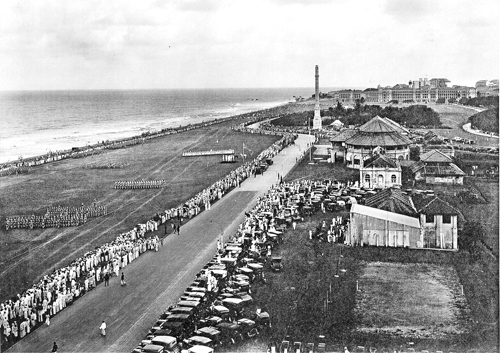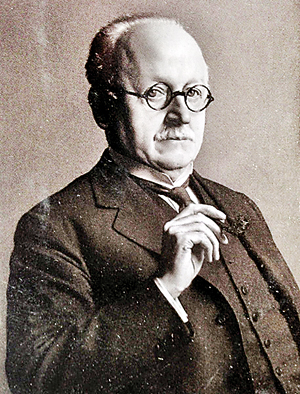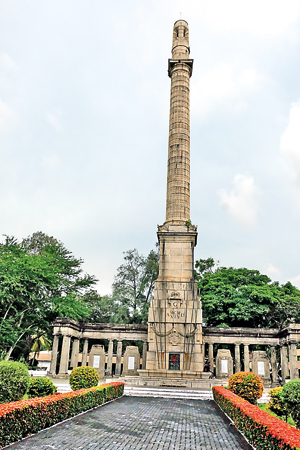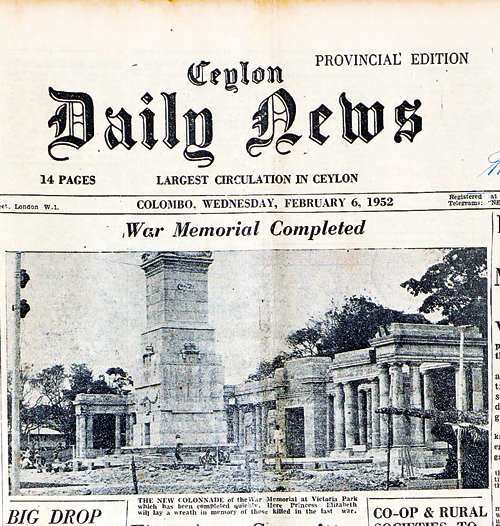The cenotaph once stood tall on Galle Face Green

Honouring their sacrifice: The War Memorial in its original location at Galle Face. Pic courtesy Lt. Cdr. (Rtd)Somasiri Devendra
‘They shall grow not old
As we that are left grow old
Age shall not weary them,
Nor the years condemn.
At the going down of the sun
And in the morning
We will remember them.
When you go home
Tell them of us and say
We gave our tomorrow
For your today.’
British poet Lawrence Binyon’s poignant ode can be found engraved as the epitaph on the War Memorial or the cenotaph (empty tomb or a monument honouring a person or group whose remains are elsewhere) that stands tall at the ViharaMaha Devi Park in Colombo. The cenotaph is a timeless reminder of the 442 service personnel who left the shores of then Ceylon and died in action in the First World War. Today, November 11, marks the centenary of the end of the war.

Sir Edward Lutyens
The majority of the names engraved on the War Memorial are of British origin with a few local names such as Wijekoon, Obeysekera, Weerakoon, Perera, Ramanathan and Samarawickreme among them. Interestingly one female name appears as ‘Miss L.Midwood’. The name ‘Ceylon’ is engraved on the upper part of the cenotaph, along with the Sinhala and Tamil translations. Below the inscription is the Royal Crown with the letters ‘RGI’ denoting ‘Rex George Imperator’ or King George V who was the British monarch at the time. The column has inscribed upon it the ‘Arms of Ceylon’ on a shield and wreaths carved at the base of the column with eagles at each corner, chained and hooded. On the shaft of the column are oak leaves.
Standing nearly 120 ft tall, the cenotaph accompanied by the backdrop arcade of several plaques, is one of the landmarks of Colombo city. Interestingly, the monument or the ‘Victory Column’ as it was originally known, was initially located at the Galle Face esplanade.
The Ceylon Independent of November 11, 1920 under the heading ‘Ceylon War Memorial- Present Position of the Fund’ notes that ‘the sum earmarked for the cost and erection of the Victory Column was R.150,000’ and ‘samples of the most suitable Indian stone were obtained and specimens forwarded to Sir Edwin Lutyens for his selection’. The newspaper account further states that the architect of the project, Sir Edwin Lutyens who is credited with the design of the White Hall Cenotaph in England and the Rashtrapati Bhavan or the Presidential Residence in New Delhi (formerly known as Viceroy’s House) had selected the site on the Galle Face lying between the Colombo Club and the Battery (a bastion of the Colombo Fort).
Historian, Prof. K.D. Paranavitana explains that this is the area between the Taj Samudra and the Presidential Secretariat. “One bastion of the Colombo Fort was located around this area and the Victory Column had originally stood where the statue of Premier S.W.R.D. Bandaranaike stands today with the backdrop of the newly built Shangri-La Hotel.”

As it stands today: The War Memorial at ViharaMaha Devi Park. Pic by Amila Gamage
The ultimate choice of a monument for those who sacrificed their lives in World War I was a matter of dispute. Among the monuments that were mooted were a hospital, a Sailors’ Home and a new lighthouse. ‘Sir Edwin Lutyens silenced all conflicting opinions’ reports the Ceylon Daily News of October 27th, 1923. The newspaper account further notes that the architect had told one of the ‘Daily News representatives’, that there should be ‘nothing commercial’ about the memorial dedicated to ‘those who laid their lives in the cause of liberty.’
The foundation stone for the monument as the engraved plaque on it confirms, was laid by the Governor, Brigadier General Sir William Henry Manning on December 7th, 1921. The Ceylon Daily News of the same day reports the event to be held under the banner: ‘Ceylon’s War Memorial, laying of the foundation stone. Today’s ceremonial at the Galle Face’. The account gives an extensive report about the preparations and the Ground Plan for the ceremony, also details of its design: “The Column will be constructed of the best Sholinghar (a district 30 miles north of Madras) granite 119 ft.6 in height and seven ft in diameter.”
The following day’s Ceylon Daily News provides an interesting account of the ceremony. “After His Excellency touched the wet cement with the silver trowel, three workmen- a Sinhalese, a Tamil and a Moorman of Messers Braid and Co. who are building the Victory Column, moved the stone to position and His Excellency declared it well and truly laid with an ebony mallet also supplied by the Colombo Stores Ltd. Copies of yesterday’s date of the five daily newspapers in Colombo and Ceylon coins, bearing this year’s date were placed in the cavity below the foundation stone.’ The ceremony was followed by a prayer.
The monument was declared open on October 27th, 1923 by Governor Manning at 7.45 a.m. as the Ceylon Daily News records. According to the newspaper account, huge blocks of stone each weighing from one to four tons that arrived from the ‘steamers’ from India, “were all hoisted into position, shaped and dressed by skilled Indian workmen.” Addressing the gathering on the day, Governor Manning who laid the foundation stone to this great monument of honour said, ‘it will bear witness to the part the men of Ceylon, both British and Ceylonese took in that great struggle and it will be enshrined in the memories of all those who rest in peace, where they fought and died.’

Relocated to its present home. Pic courtesy the Daily News
With the outbreak of the Second World War in 1939, it was decided by the authorities that the Victory Column on the Galle Face esplanade would be a notable landmark to enemy aircraft and thus it had to be dismantled. After much deliberation as to where it should be relocated, it was finally decided to erect it at its present location- then known as the Victoria Park. Governor of Ceylon, Lord Soulbury took the decision to add a backdrop of columns and plaques bearing the names of those who lost their lives between 1939 and 1945 in the Second World War.
The Ceylon Daily News of February 6th, 1952 headline announces: ‘War Memorial Completed’. The caption reads that the ‘Princess Elizabeth will lay a wreath in memory of those killed in the last war.’ The Royal visit to the island was however cancelled due to an unexpected turn of events when King George VI died suddenly. ‘The King dies in his sleep, Princess Elizabeth ascends the British throne’ the Ceylon Daily News of February 7th, 1952 proclaimed in bold letters.
With the unexpected demise of King George VI, the royal itinerary was altered, as the Princess had to return to England from Kenya. “A hush of sadness was cast over Ceylon yesterday evening,” the Ceylon Daily News reported. Representing the Royal who had cut short her commonwealth tour, Lord Soulbury had later placed a poppy wreath at the cenotaph.
The war monument which is of archaeological value has been renovated by the Sri Lanka Ex-Servicemen’s Association (SLESA) with the assistance of SL Navy which is responsible for its maintenance. A few years ago, SLESA added a decorative fence in front of the cenotaph along with concrete interlocking paving blocks. Flash lights were also installed to illuminate the monument at night.


